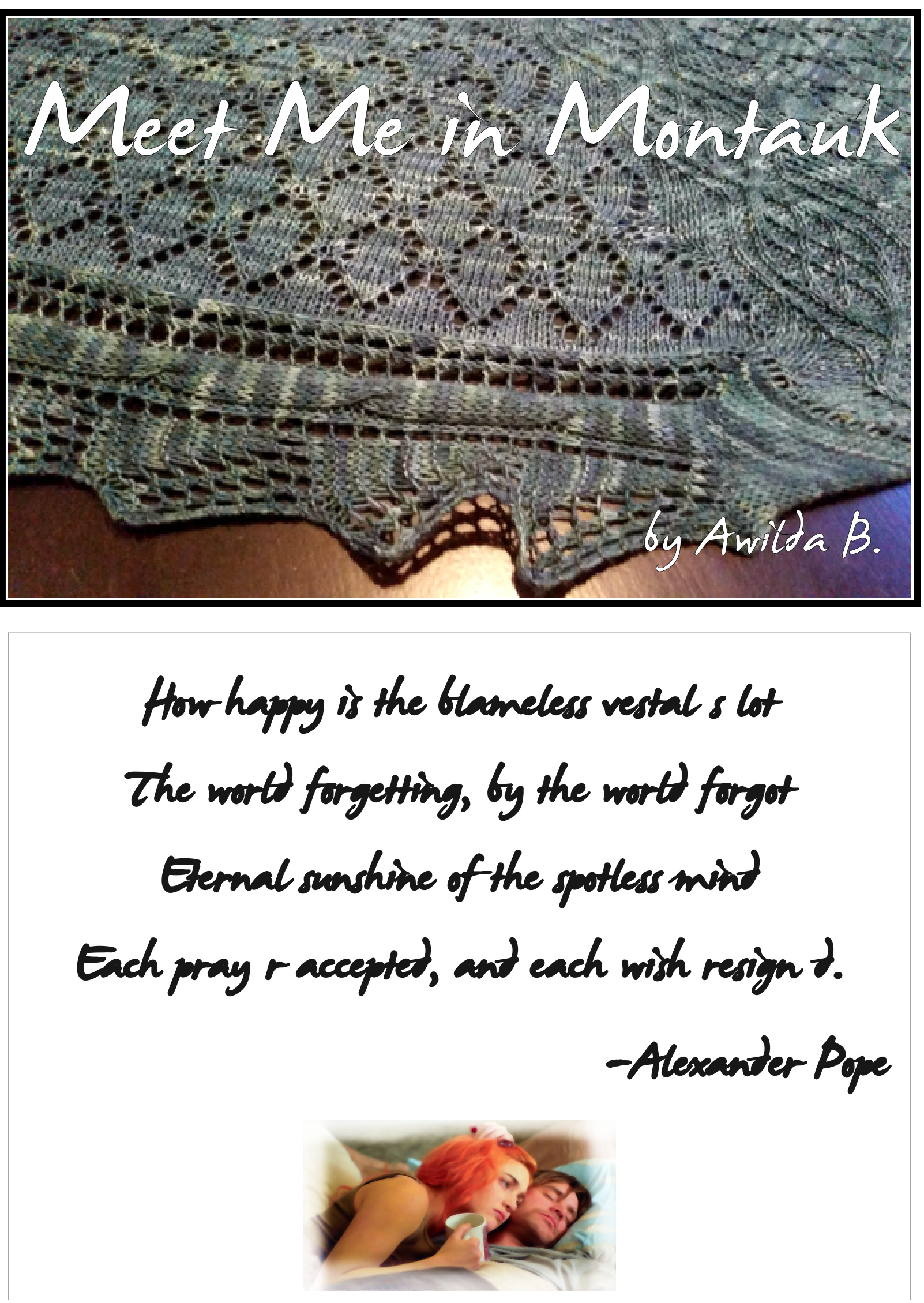
Materials
Five skeins of KnitschYarns 1oo% Merino Sock, orapproximately 78o meters (855 yards) similar fingering weight yarn. Shawls are shown in the "Emo Nemo" (teal) and \*The Dark Side' (purple) Knitsch colourways.
Tools
· One 3.75mm (US Size 5) circular needle, at least 6o cm (24 inches) and ideally 1o0 cm (4o inches) long. You will also need a shorter 3.75mm (US 5) circular needle, or a set of 3.75mm (US 5) DPNs. Stitch Markers, and one cable needle or small double pointed needle to work the centre cable.
Skills Needed
Basic lace knitting skills (knit; purl; yo; k2tog; p2tog; ssk, sk2p) Moderate cable knitting skills (1x1 cross, 2x1 cross, 3x1 cross, 2x2 cross, 3x3 cross, 5x5 cross) Picking up stitches from an edge Short Rows (wrap and turn)
Gauge
Gauge when blocked is approximately 24 stitches over 10 cm (4 inches) in stockinette.
Finished Dimensions
Approximately 163 cm (64 inches) across the widest point and 72.5 cm (28.5 inches) from top centre to bottom centre.
Abbreviations
K: Knit Ktbl: Knit through the back loop PM: Place marker P2tog: Purl two together K2tog: Knit two together M1: Make one. This can be any method you choose that will not result in a hole - knit in the front and back loop of one stitch, pick up the loop from the stitch below, or pick up the bar between the stitch just knit and the next stitch. Whichever method with which you're most comfortable. P: Purl Sk2p: Slip one stitch knitwise, knit two together, pass slipped stitch over SM: Slip Marker SSK: slip one stitch knitwise, slip second stitch knitwise, knit the two stitches together through the back loop. Decrease 8 to 1: K1, slip st back to left needle, pass the next 7 sts over the slipped st, K the stitch again.
Cable Twists
3x3 Back Cross: Slip next 3 stitches to cable needle and hold to back, K3, K3 from cable needle. P under K2 Back Cross: Slip 1 stitch to cable needle and hold to back, K2, P1 from cable needle. P under K Back Cross: Slip 1 stitch to cable needle and hold to back, K1, Pi from cable needle. K2 over P Front Cross: Slip 2 stitches to cable needle and hold to front, P1, K2 from cable needle. P under K3 Back Cross: Slip 1 stitch to cable needle and hold to back, K3, P1 from cable needle. WS P under P Cross: Slip 1 stitch and hold to back, P1, P1 from cable needle. K3 over P Front Cross: Slip 3 stitches to cable needle and hold to front, P1, K3 from cable needle. K over K Front Cross: Slip 1 stitch and hold to front, K1, K1 from cable needle. K over P Front Cross: Slip 1 stitch to cable needle and hold to front, P1, K1 from the cable needle. K under K Back Cross: Slip 1 stitch and hold to back, K1, K1 from cable needle. K2 over P2 Front Cross: Slip 2 stitches to cable needle and hold to front, P2, K2 from cable needle. 2x2 Back Cross: Slip 2 stitches to cable needle and hold to back, K2, K2 from cable needle. P2 under K2 Back Cross: Slip 2 stitches to cable needle and hold to back, K2, P2 from cable needle. 4x3 Front Cross: Slip 4 stitches to cable needle and hold to front, K3, K4 from cable needle. 3X4 Back Cross: Slip 3 stitches to cable needle and hold to back, K4, K3 from cable needle.
Getting Started
This pattern is made up of a centre cable panel, two body lace panels, and two edge panels. Allinstructions are provided in written and charted form. The body is broken up into a beginning chart, a middle chart, and end chart, and there are two edge charts for each side. Once the edge charts have been completed, the shawl is done - there is no binding off.
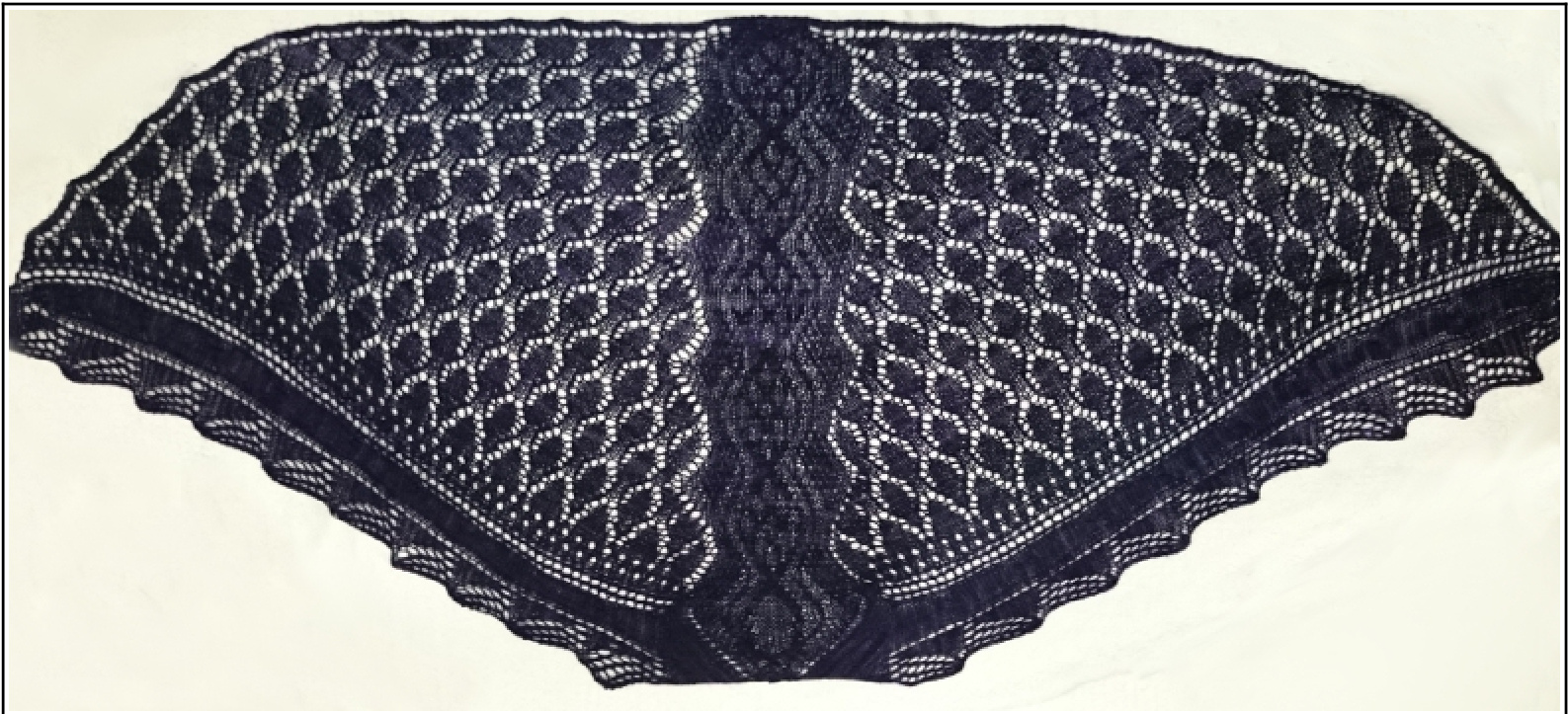
Cast on 3 stitches. Knit 12 rows. At the end of these 12 rows you willhave a small rectangular piece of garter stitch fabric. Turn and knit another 3 stitch row.Then at the end ofthis row, pick up and knit one stitch in each ofthe 6 garter ridges along the long left side →9 stitches on the needle. Next, pick up and knit three stitches from the cast on edge. →12 stitches on the needle. Next Row (RS): K3, PM, [K1, M1] 6 times, PM, K3. →18 sts (3 border - 12 body - 3 border). Next Row (WS): K3, SM, P to next marker, SM, K3. Next Row (RS): K3, SM, [K2, M1] 6 times, SM, K3. →24 sts (3 border - 18 body - 3 border). Next Row (WS): K3, SM, K2, P1, K3, P6, K3, P1, K2, SM, K3. Stitch check! At the end of this section you will have 24 stitches.
Section 1 (Chart 1)
Things to Remember:
Each row begins and ends with three stitches K on both the right and wrong sides. These stitches are not charted. The only markers you need are the ones that separate the edge stitches from the rest of the patterning. The centre panel and lace patterning change too much for repeat markers to be useful. There will always be aYO between the lace knitting of the body and the purls that start and end the center panel - once the pattern is established and the edges of the centre panel move, remembering this will help you "read" your work and know where the edges of the centre panel are. There are seven WS rows highlighted in grey on both the chart and the written instructions. These rows have a 1x1 cable cross in the midle of the row; otherwise, you will be knitting the knits and purling the purls (and the YOs) as you come to them. Check your work from time to time to make sure your cable crosses and lace patterning are lining up and you'll be fine.
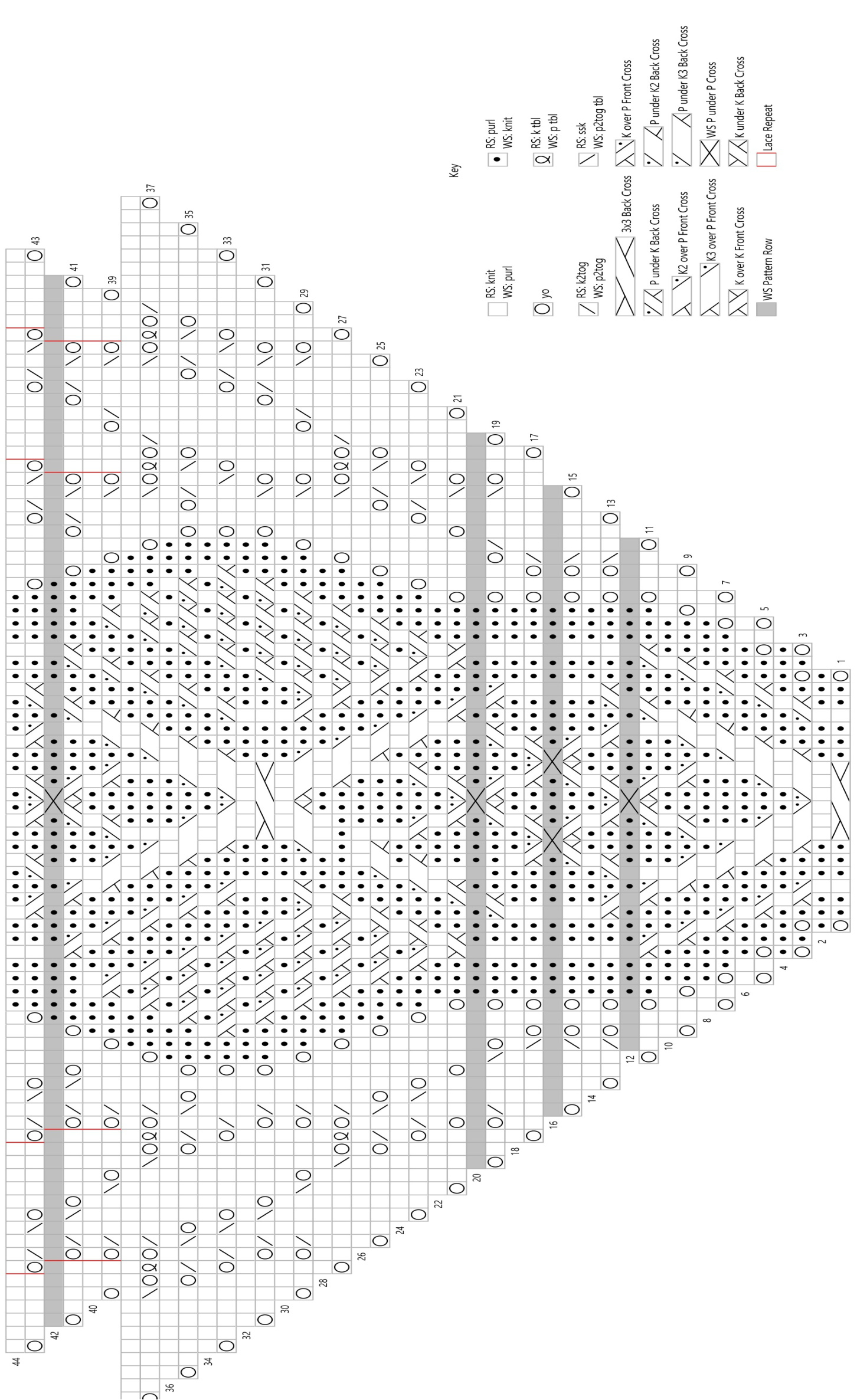
Section 2 (Chart 2)
Things to Remember:
This section continues on from the last, in pattern. Like Section 1, each row begins and ends with three stitches K on both the right and wrong sides, and they are not charted. Repeat the chart four times while increasing the number of lace pattern repeats as specified. At the end of the First Repeat, you will have 17o stitches on the needles. At the end of the Second Repeat, you will have 23o stitches on the needles. At the end of the Third Repeat, you will have 29o stitches on the needles. · At the end of the Fourth Repeat, you will have 350 stitches on the needles.
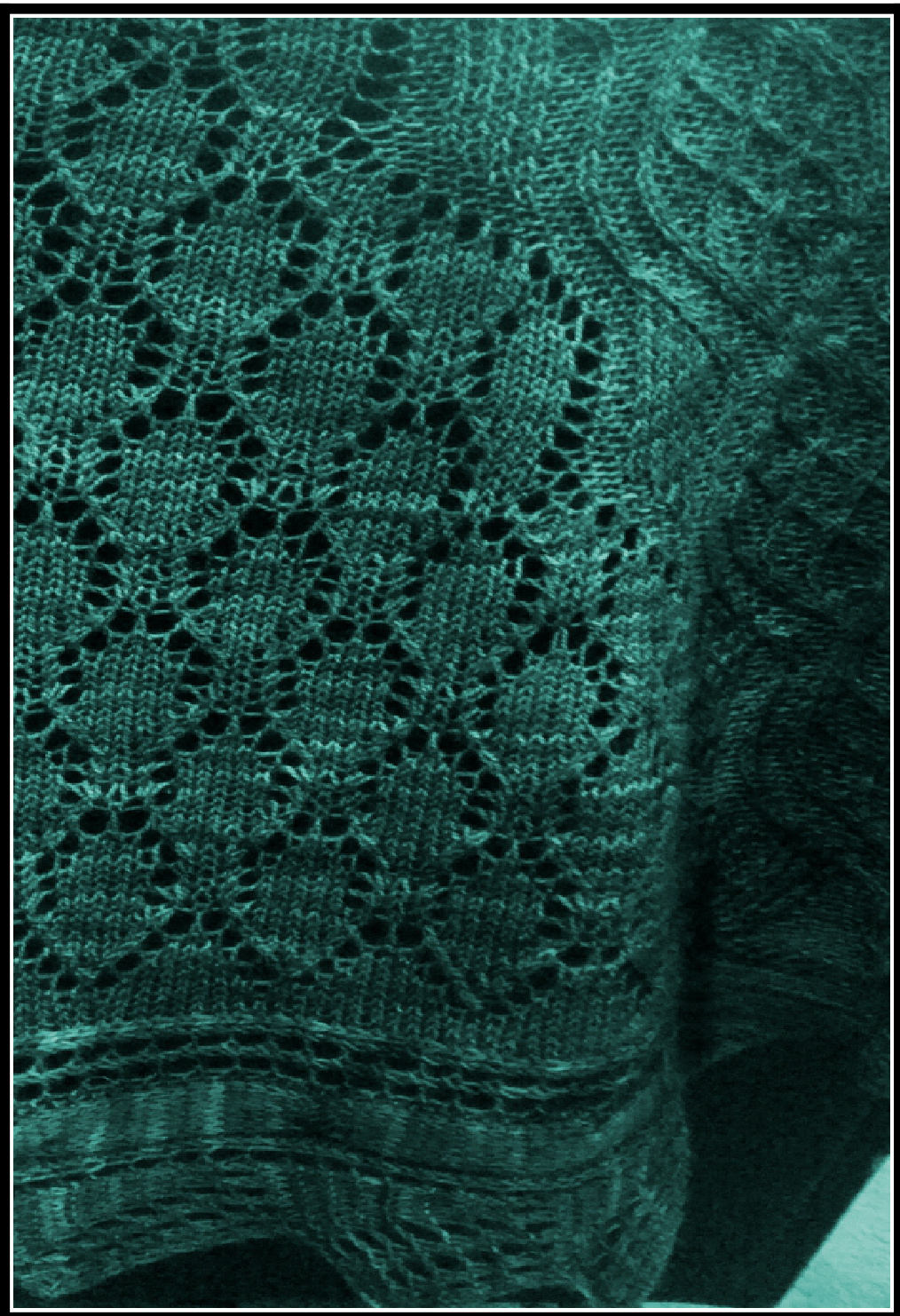
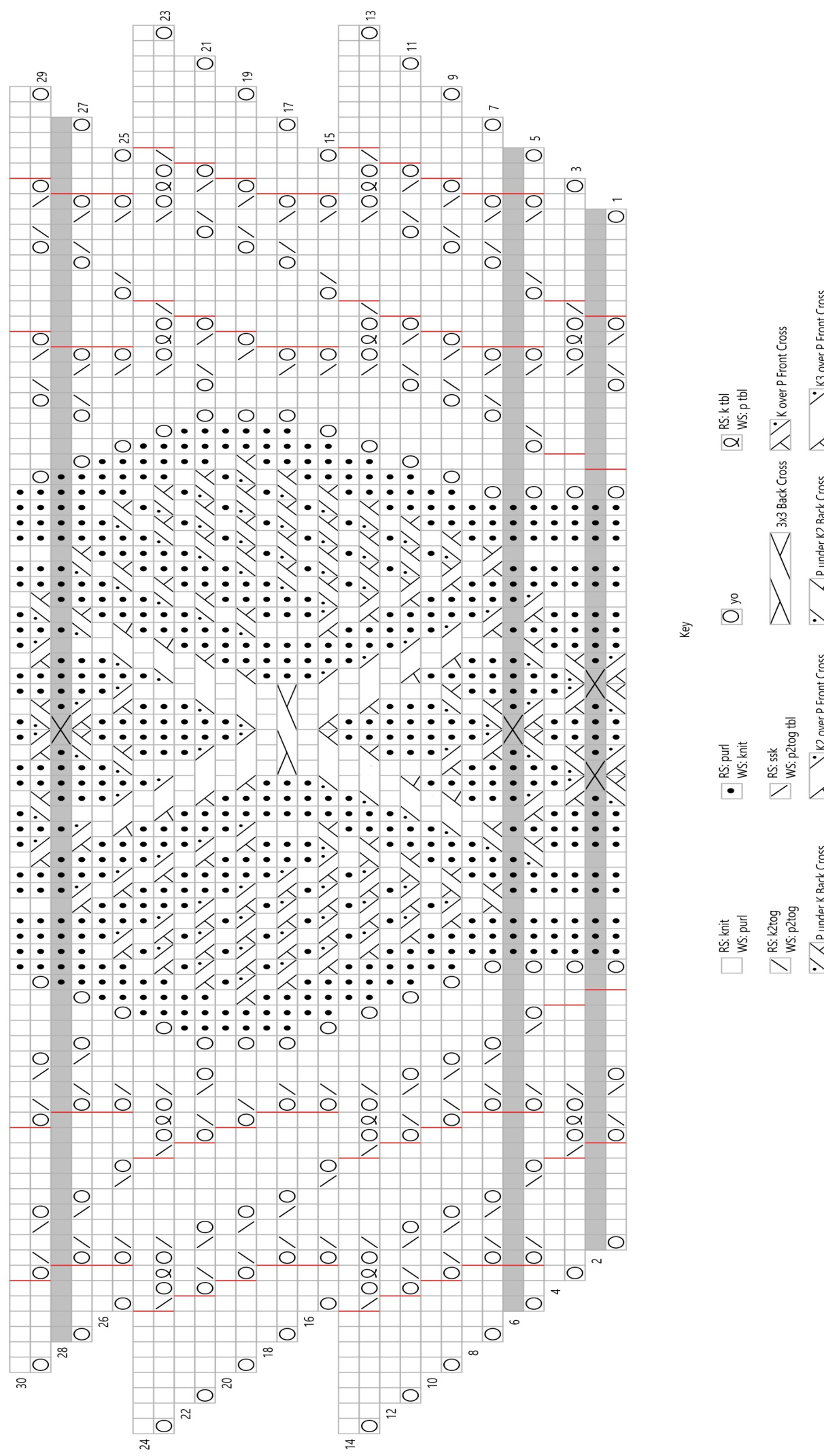
Section 3 (Chart 3)
Things to Remember:
This section continues on from the last in pattern until Row 12, including the three uncharted K stitches at the beginning and the end of each row. Beginning on Row 13, the pattern changes from row to row. After the first half of Row 13 is complete, all stitches except the centre panel stitches are held live. You will only be working with the centre panel stitches until they have all been bound off.
IMPORTANT:
The instructions are written so that you can keep the live stitches from the two halves of the shawl on the working needle if you are using a long circular needle. After the centre panel is bound off, you will have 167 stitches on the left needle and 168 stitches on the right needle (right side facing) with the needle tips pointed at the bound off area. After the k2tog on Row 48, cut yarn and pull end through remaining stitch.
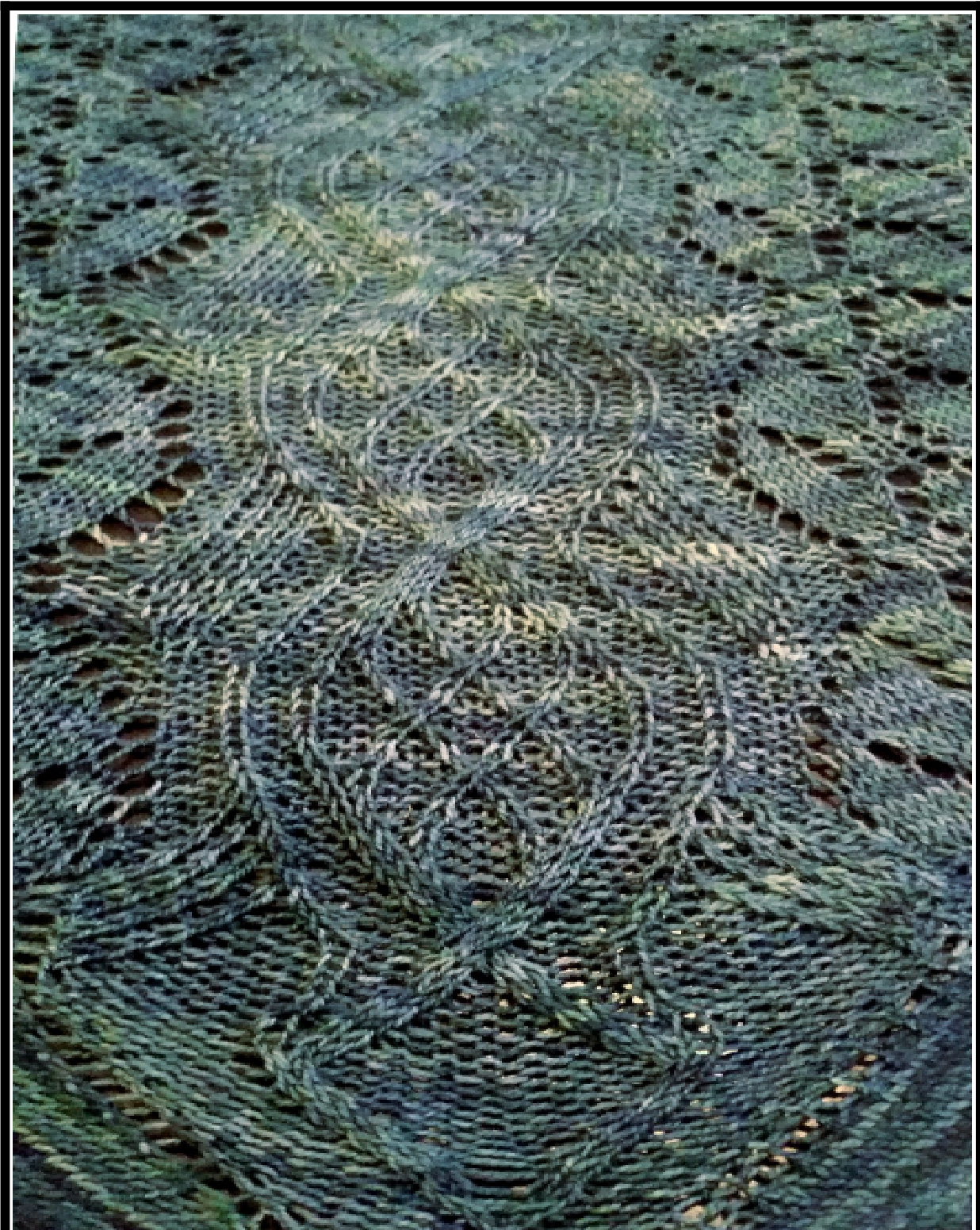
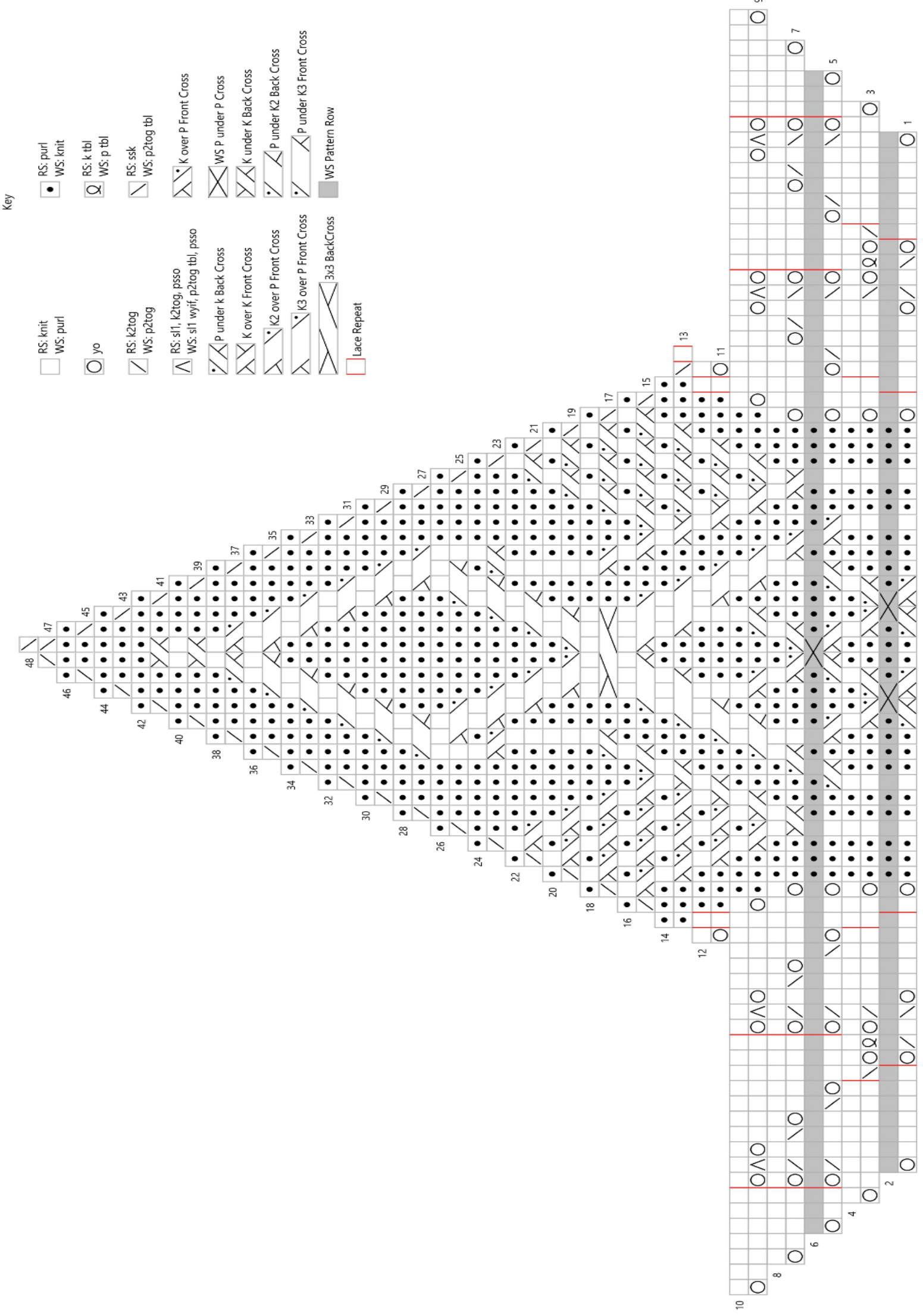
Section 4: Edging
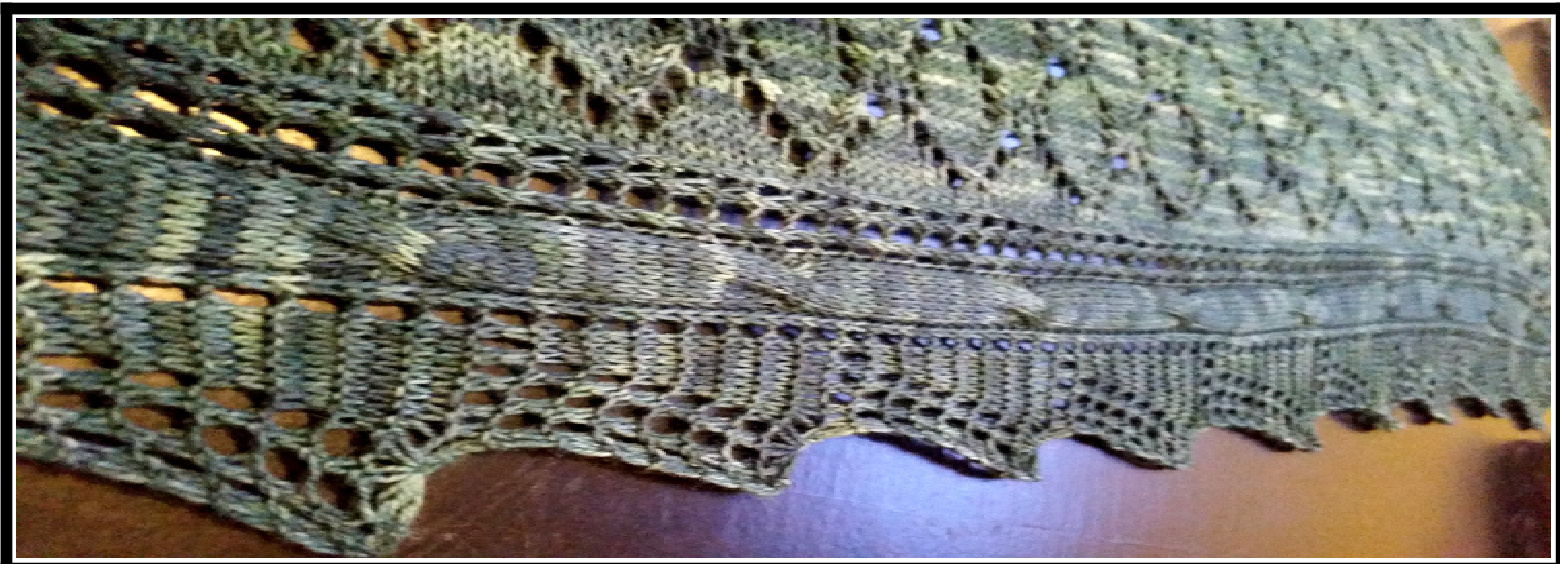
Things to Remember:
You will be using a shorter circular needle or DPNs and knitting the edging onto the body as you go. Body stitches are joined on both the beginning (RS) and end (Ws) of the edge rows. Edge 1 (a and b) is worked first, from the centre panel to the edge, then Edge 2 (a and b). There is short row shaping while setting up, done on the WS on Edge 1 and the RS on Edge 2. 0 To wrap and turn (W&T) on the WS: move the yarn to the back of your work, slip the next stitch from the left needle to the right needle, bring the yarn to front, and place the slipped stitch back on the left needle. Turn work to the RS. To W&T on the Rs: bring the yarn to the front of your work, slip the next stitch from the left needle to the right needle, move the yarn to the back, and place the stitch back on the left needle. Turn the work to the Ws.

First Edge
With RS facing, pick up all ofthe purl bumps along the right edge ofthe centre panel with the left needle, starting at the bound off tip. →17 sts. Starting from the shawl body end (RS): K4, \*Knit in front and back ofthe next stitch; repeat from \* 8 times, k4.→26sts. Next row (WS): K2, P to end. Next Row: K to end. Next Row: K2, P to 3 stitches before end, W&T. Next Row: K to end. Next Row (WS): K2, P to 3 stitches before last turn, W&T. Next Row (RS): K to end. Repeat the last two rows 1o more times. Next Row (Ws): K2, P23 while picking up and purling wraps with the stitch it wrapped, P the last stitch with a stitch from where the centre panel meets the shawl body and the first live stitch from the body (purl the 3 together) to close the gap. Begin Edging 1a . Repeat the chart 9 times total.
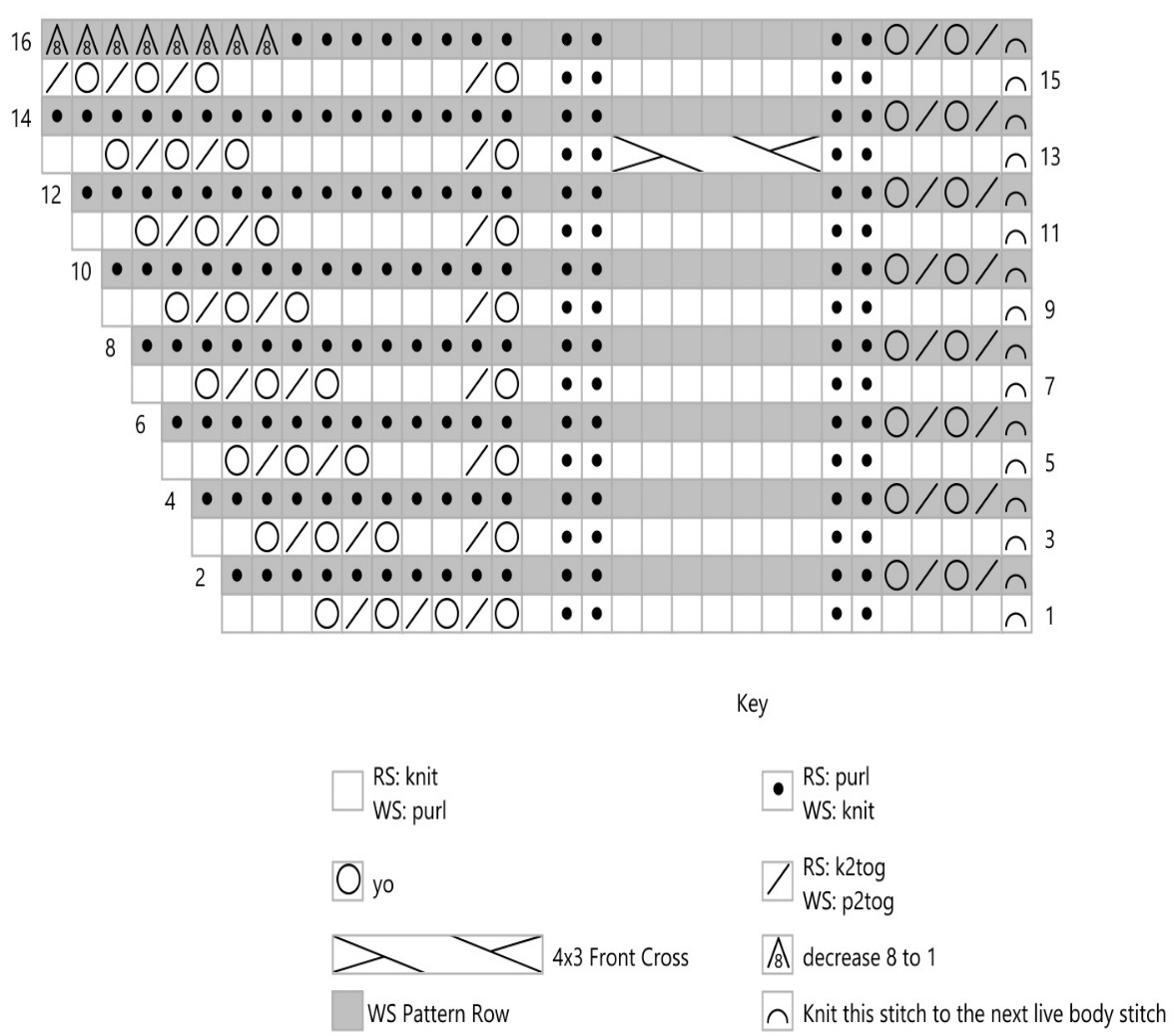
Then, work Edging ib once.
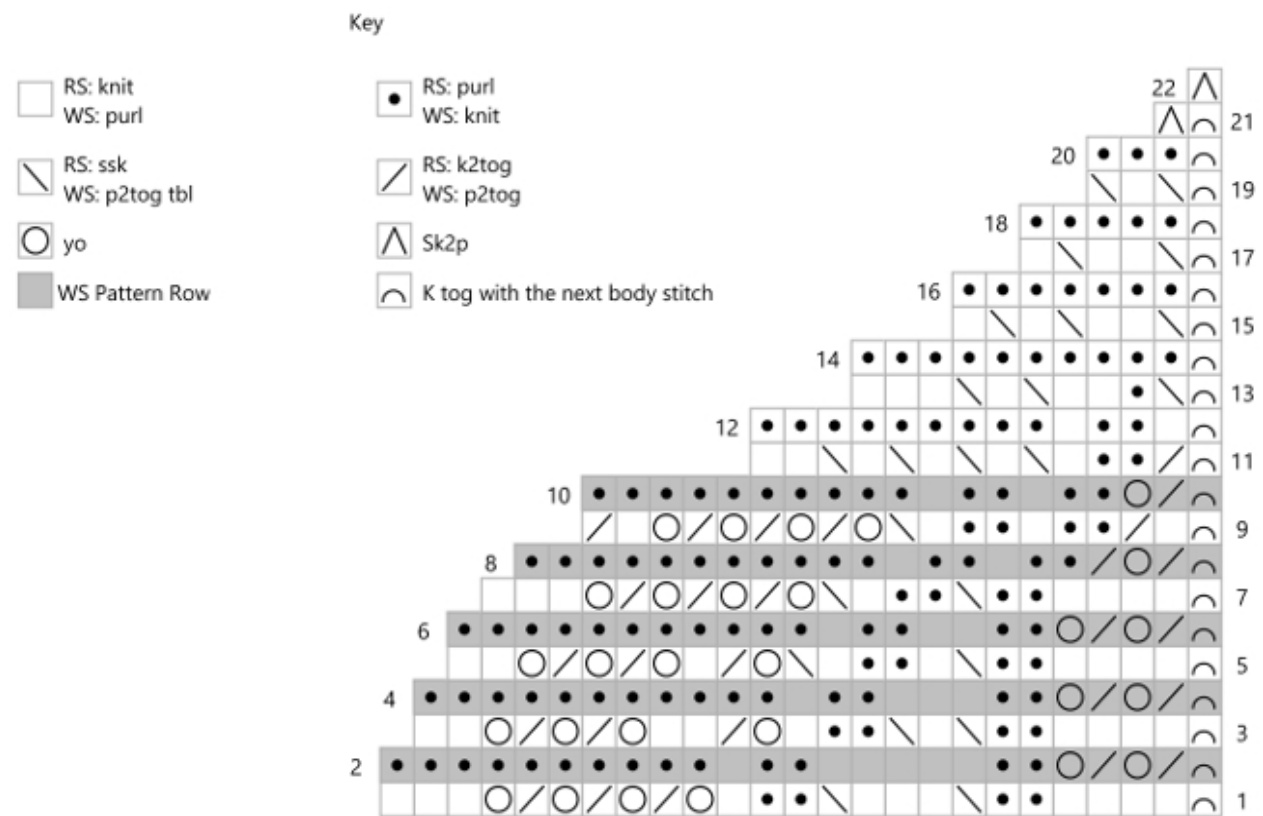
Second Edge
With RS facing, pick up allof the purl bumps along the left edge ofthe centre panel with the right needle, starting from the bound offtip. →17 sts. Starting from the shawl body end on the Ws: P4, \*Knit in front and back of the next stitch; repeat from \* 8 times, P4. → 26 sts. Next row (RS): K to end. Next Row: P to lasts 2 sts, k2. Next Row: K to 3 stitches before end, W&T. Next Row: P to last 2 sts, k2. Next Row (RS): K to 3 stitches before last turn, W&T. Next Row (WS): P to last 2 sts, k2. Repeat the last two rows 1o more times. Next Row (RS): K25 while picking up and knitting wraps with the stitch it wrapped as you come to them, then kthe last stitch with a stitch from where the centre panel meets the shawl body and the first live stitch from the body (knit the 3 together) to close the gap. Next Row(Ws): Pthe first stithtogetherwith the next live stitchheld from the bodythroughthe backlop, pto end. Begin Edging 2a now. Repeat the chart 9 times total.
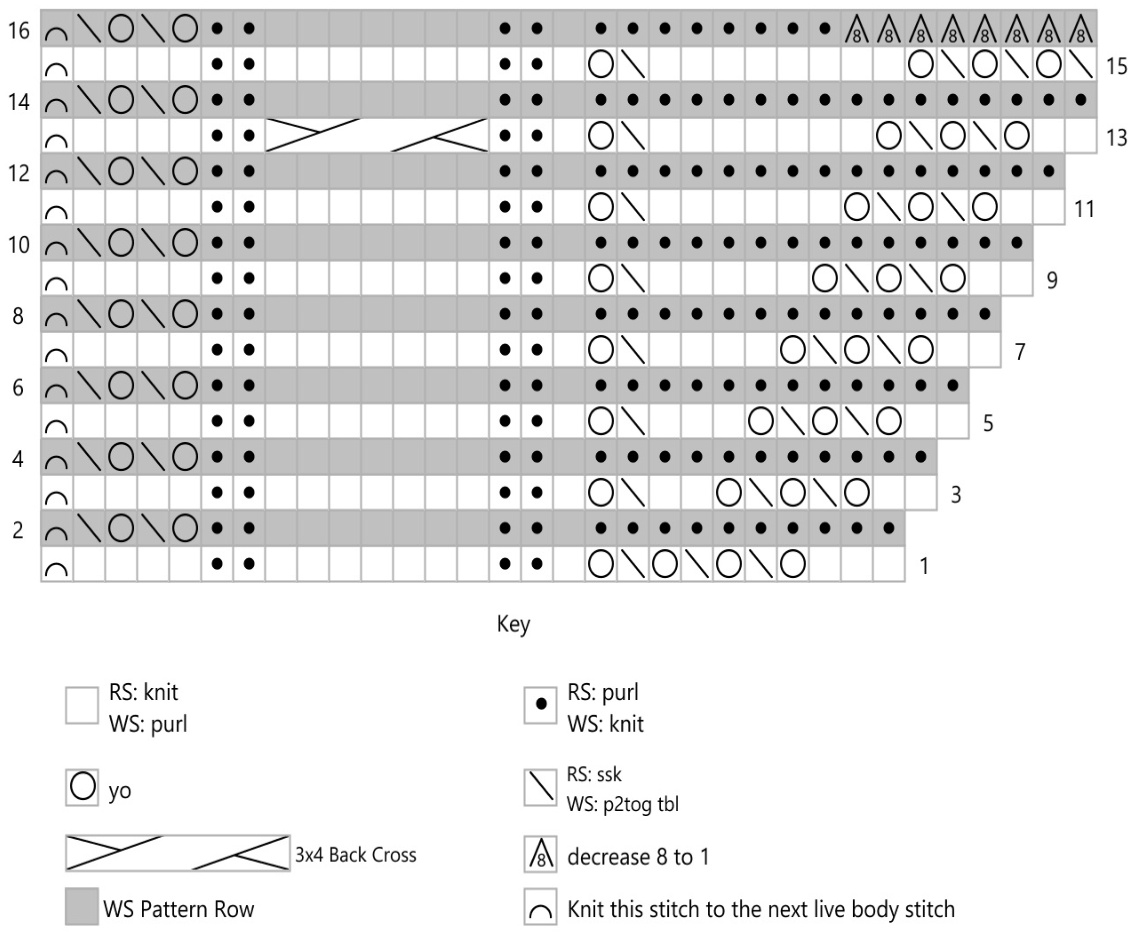
Next, work Edging 2b once.
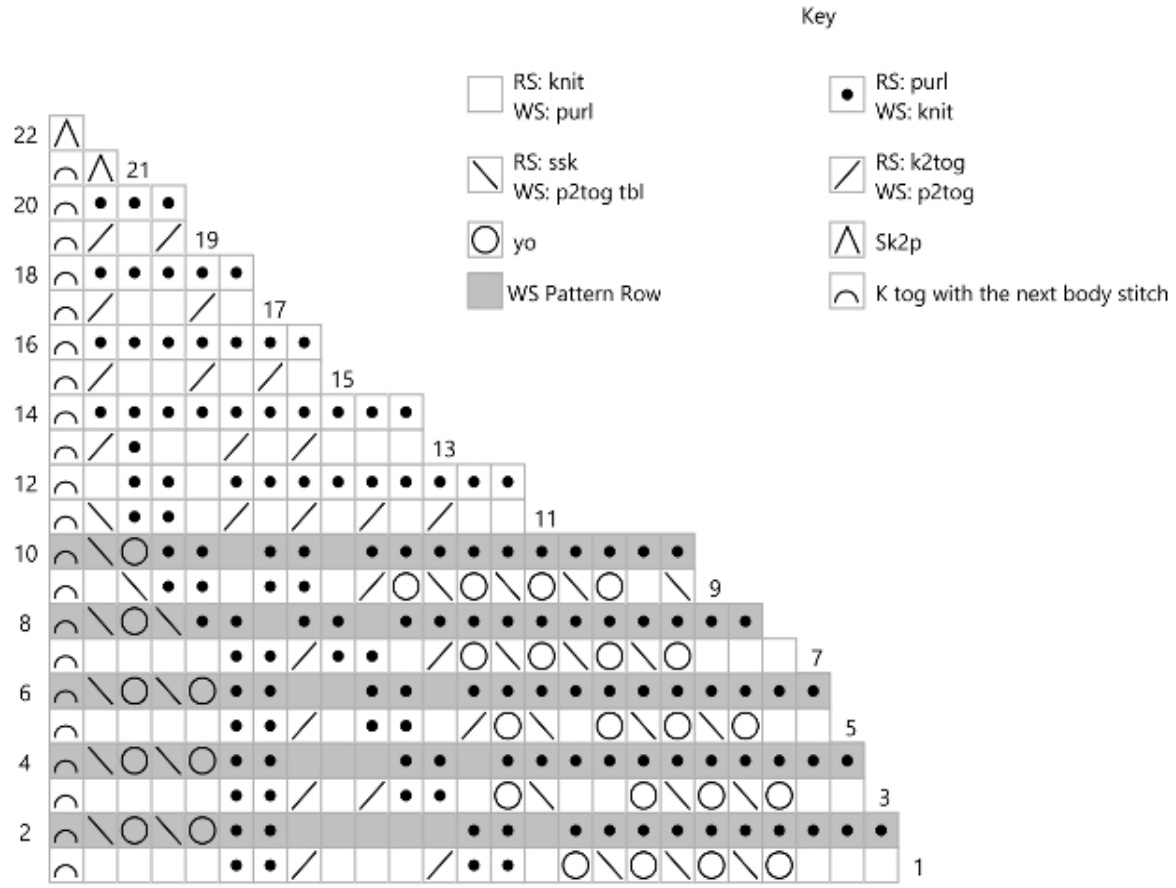
Finishing
Block to finished dimensions: approximately 163 cm (64 inches) across the widest point and 72.5 cm (28.5 inches) from top centre to bottom centre. Remember, this is not a perfect half circle shawl - the top edge curves down a bit at the tips. The lace at bottom edge can be blocked to either points (as pictured) or a more rounded edge, depending on preference.
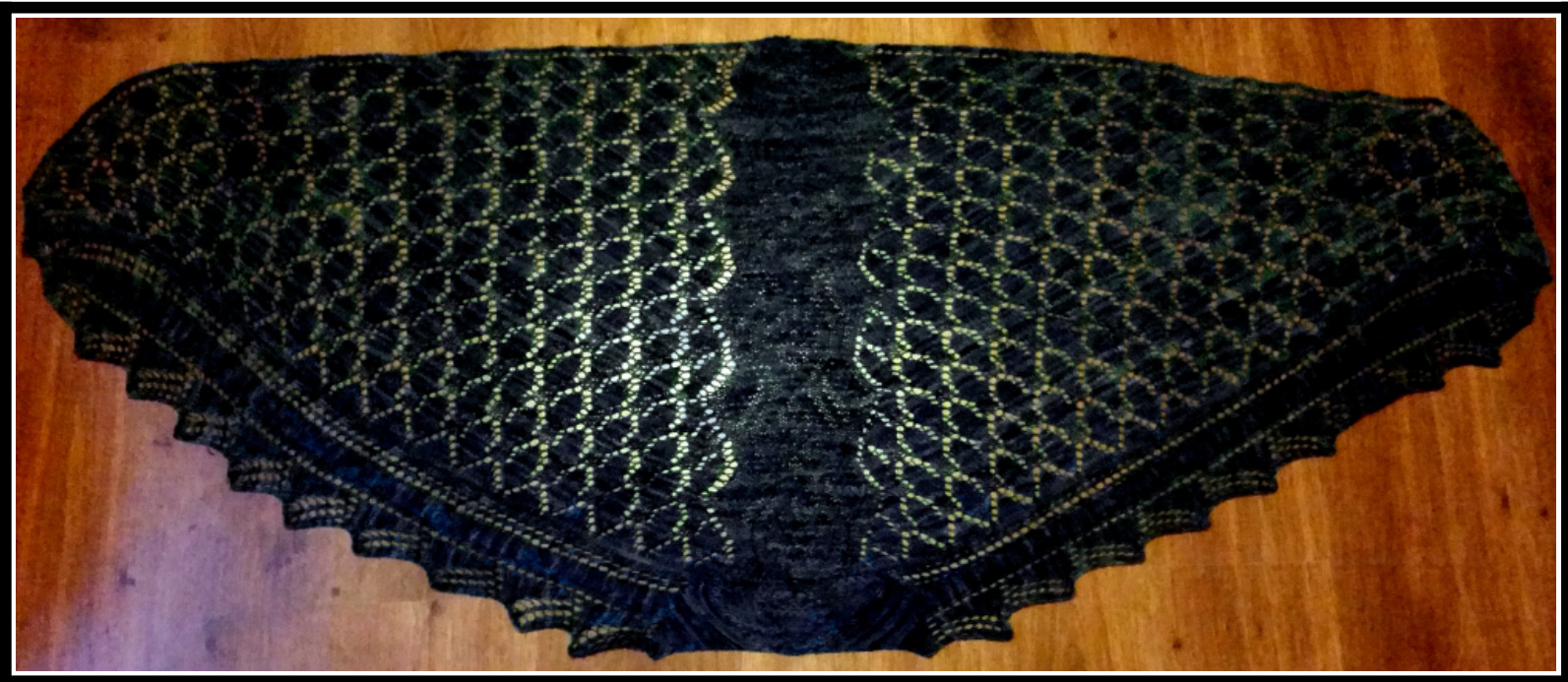
Have Any Questions? Feel free to message me (Awilda on Ravelry), or come join our group at Awilda B. Designs!










